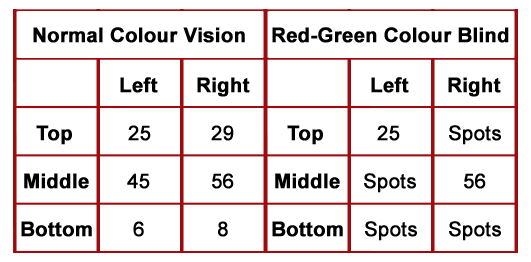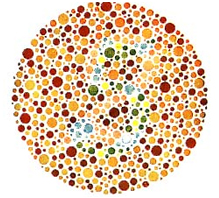
Colour Deficiency
- People with protanopia lack the long-wavelength sensitive retinal cones that are required to distinguish between colours in the green-yellow-red section of the spectrum.
- People with dueteranopia lack medium-wavelength retinal cones and are therefore also unable to distinguish between colours in the green-yellow-red section of the spectrum.
- People with colour blindness involving the inactivation of the short-wavelength sensitive cone system have tritanopia, a very rare blue-yellow colour blindness.
The symptoms of more serious inherited colour vision problems and some types acquired problems may include:
- Objects appear as various shades of gray (this occurs with complete colour blindness and is very rare)
- Reduced vision
Nystagmus
The most severe form of colour blindness is achromatopsia. A person with this rare condition cannot see any colour. Achromatopsia is often associated with lazy eye, nystagmus (small, jerky eye movements), severe light sensitivity, and extremely poor vision.
Detection and Diagnosis
Colour vision deficiency is most commonly detected with special coloured charts called the Ishihara Test Plates. On each plate is a number composed of coloured dots. While holding the chart under good lighting, the patient is asked to identify the number. Once the colour defect is identified, more detailed colour vision tests may be performed.
Ishihara Test for Colour Blindness

I am colour blind, as is about 12 - 20 percent (depending on whose figures you want to believe) of the white, male population and a tiny fraction of the female population. Most of these circles are nothing but spots to me. Below are the correct answers to what a person with normal colour vision would see - and what I see (and most people with Red-Green colour blindness). When you see what we can't see, you may understand why it's so tough to find the right sox and why we like bright colours, which are often identifiable.

Another interesting colour blindness test is below
 The test to the left is simpler.
The test to the left is simpler.
The individual with normal colour vision will see a 5 revealed in the dot pattern.
An individual with Red/Green (the most common) colour blindness will see a 2 revealed in the dots.
Source:http://en.wikipedia.org/wiki/Colorblind#Causes / http://www.toledo-bend.com/colorblind/ishihara.html